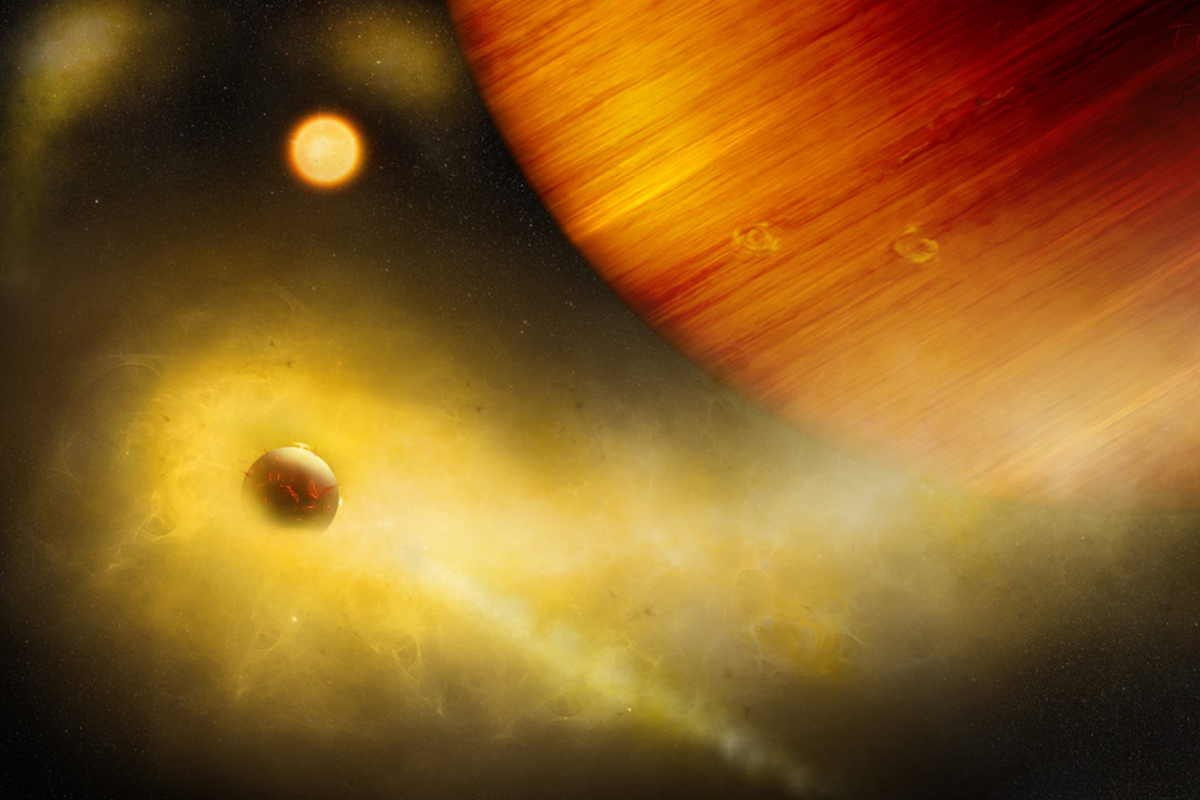Scientists May Have Found a Volcanic Exomoon That Darth Vader Could Call Home

Scientists may have found a volcanic world on the verge of destruction, where the chances of finding life are highly unlikely. One scientist compared the spot to a fictional, lava-strewn world from "Star Wars."
But instead of an alien planet, the world appears to be a volcanic moon, much like Jupiter's volcano-covered satellite Io, in orbit around an exoplanet called WASP-49. That planet orbits a star located 550 light-years away from Earth, in the constellation Lepus, completing one orbit every three Earth days.
A team of scientists at the University of Bern in Switzerland said that hot, bubbling lava may flow on the surface of this exomoon, or moon orbiting a planet outside of our solar system. That conclusion is based on the high levels of sodium gas detected at the planetary system. The moon's presence is suggested by observations of WASP-49b's parent star and by theoretical models, researchers said.
Related: That's No Moon? Proposed Exomoon Defies Formation Theories
"It would be a dangerous volcanic world with a molten surface of lava," Apurva Oza, a postdoctoral fellow at the Physics Institute of the University of Bern and co-author of the new study, said in a statement from the University of Bern. "A place where Jedis go to die, perilously familiar to Anakin Skywalker."
(Oza was referring to the volcanic Mustafar, the fictional "Star Wars" planet where Skywalker was maimed in a lightsaber battle with his mentor, Obi-Wan Kenobi, and later set up a castle as Darth Vader.)
An alien Io from beyond
The exomoon is described as an extreme version of Jupiter's moon Io. The fifth moon of Jupiter, Io is the most volcanically active body in the solar system, with hundreds of volcanoes on its surface.
Breaking space news, the latest updates on rocket launches, skywatching events and more!
By comparing observations of Io to those of the potential exomoon, in addition to calculations of the exomoon's loss of mass and levels of sodium in the planetary system, the team believe that they have found the first exo-Io (an Io-like moon) beyond the solar system, according to the statement.
"The sodium is right where it should be," Oza said. "The neutral sodium gas is so far away from the planet that it is unlikely to be emitted solely by a planetary wind."
Another key factor comes in the tidal forces released by the planetary system, which keep the moon's orbit stable while also heating it up and making it potentially volcanically active. However, the team of researchers need more evidence in order to prove that the exomoon is in fact volcanically active. They are looking to gain more data through ground- and space-based observations of the planetary system.
Oza noted that a world like WASP-49b is on the verge of destruction due to its ongoing loss of mass, adding, "The exciting part is that we can monitor these destructive processes in real time, like fireworks."
The study was released on Aug. 29 and accepted for publication by The Astrophysical Journal.
- First Exomoon Found? Neptune-Size World Possibly Spotted Orbiting Alien Planet
- Life Outside Our Solar System Might Exist on Exomoons
- Exomoons Around Alien Planets May Be Too Small for Life
Follow Passant Rabie on Twitter @passantrabie. Follow us on Twitter @Spacedotcom and on Facebook.

Passant Rabie is an award-winning journalist from Cairo, Egypt. Rabie moved to New York to pursue a master's degree in science journalism at New York University. She developed a strong passion for all things space, and guiding readers through the mysteries of the local universe. Rabie covers ongoing missions to distant planets and beyond, and breaks down recent discoveries in the world of astrophysics and the latest in ongoing space news. Prior to moving to New York, she spent years writing for independent media outlets across the Middle East and aims to produce accurate coverage of science stories within a regional context.
